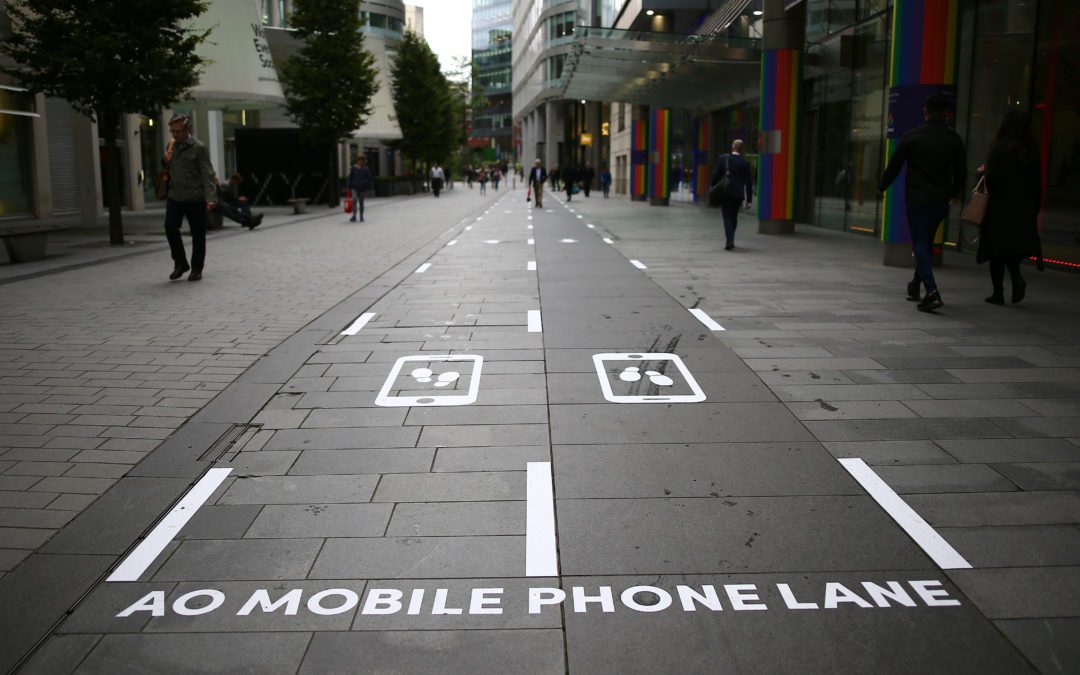- Research reveals increase in distracted pedestrians bumping into each other because they’re engrossed by their phone – with 75% of Brits saying they are guilty of this.
- 59% of the population think that people spend too much time looking down at their phones in public and it’s become nuisance – with 40% believing authorities should intervene.
- 250-foot lanes with special markings installed to direct people who just can’t take their eyes off their screens.
- Rise of the ‘D.A.L.A.P” as the average Brit now checks their phone 6.2 times per hour, with 1 in 3 Brits saying they’ve collided with another pedestrian because they weren’t paying attention.
Two adjacent 75-metre long (247ft) ‘mobile phone safe lanes’ have been installed in central Manchester, after new research by AO-Mobile that found that a staggering 96% of the population say that they have experienced someone walking and not paying attention because they were too busy looking at their phone, in the last 12-months.
Thought to be the first of its kind in Europe, the trial, which is located in the Spinningfields district of the city centre, features a designated pathway for pedestrians to help stop people who walk with their eyes glued to their mobile phones from bumping into each other.
The pavements along Hardman Boulevard – a busy pedestrian thoroughfare surrounded by offices, shops, bars and restaurants, used by tens of thousands of people every week – now has arrows and signs that mark out separate walking lanes on the pavement exclusively for slow-walking smartphone users.
A whopping 75% of Brits say they are guilty of walking and using their phone at the same time, according to the new research.
The rise in so-called “DALAPs” (Distracted As Looking At Phone) and “distracted walking” (a behaviour recognised by The World Health Organisation) is when people walk whilst looking down at their phone in their hand rather than looking where they are going or concentrating on their surroundings – typically because they are instead texting, on social media, reading emails or video calling.
When asked if mobile phone usage is a cause for concern when it comes to public safety, 19% of people feel the government and local councils should step-in or provide guidelines, with a further 21% admitting initiatives such as sign warning people in busy areas to look where they are going, would be useful. However, 7% of people felt this would be silly or an overreaction.
70% say they regularly walk and text, completely oblivious to what is going on around them. 1 in 5 (19%) say they are guilty of walking and video calling, 44% say they walk and use social media and 42% say they regularly walk and respond to emails on their phones, without paying attention to anything else.
As a result, 38% of Brits say that someone has actually physically bumped into them, albeit apologising afterwards.
However, a 27% said someone has bumped into them and not even bothered to apologise for doing so .
A further 25% admit they’ve experienced a ‘near miss’ where they had to move out of the way at the last second to avoid a collision due to ‘distracted pedestrians’.
The most common locations for this taking place are when people are doing their shopping (55%) or when walking to or from work in the morning or evening (35%)
Richard Baxendale, MD of AO-Mobile, said: “We have to be realistic and responsible when it comes to the way society is changing. Our research found Brits being distracted by technology when walking is becoming an issue people want tackled. Our trial slow lane is an important first step that may well be adopted by other cities in the future.”
“AO-Mobile is all about making mobile phones simpler and we wanted to highlight that people should pay attention to our new deals and customer service, rather than keeping their head down and missing out.”
OWN FAULT?
Three-quarters of the population (75%) admit that the blame doesn’t just lie with other people and that they themselves are in fact guilty of being distracted and nearly causing a collision with another person (having done so in the last 12 months).
35% say they have actually bumped into someone – with 8% of people admitting they have caused damage to another person’s property, or worse resulting in someone being injured or hurt (4%).
Nearly 1 in 5 people (18%) say they’ve ended up ‘exchanging words’ after bumping into someone or nearly doing-so, with 2% even saying they have come to blows or pushed someone after they collided because of being distracted by their phone while walking.
As well as bumping into people, 29% of the population say that they have had the embarrassment of walking into a lamppost, with a further 44% say they have tripped-up when walking and not concentrating because of their phone.
Meanwhile a whopping 38% say they have walked the wrong way or past their destination as a result of not paying attention – sometimes causing them to be late for work or a meeting (11%).
The study by AO-Mobile also found that 59% of the population think that people spend too much time looking down at their phones in public and it’s becoming an increasing nuisance – although 24% say they accept it is now just part of modern-day life.
When it comes to checking our phones, 23% of people say they check their phone ten or more times every hour – with only 8% of people claiming they check their phone once or less per hour.
The study also found that when awake, the average Brit checks their phone on average of 6.2 times per hour, so assuming we slept for 7 hours each day means we look at our phone 105.4 times per day – which is easy to see why people walk and use their phone at the same time.
However, when asked if they are ‘addicted’ to checking their phone, 43% said they disagreed.
83% said that they agreed that using your phone in public can be a health hazard if you are not concentrating – and 51% agreed when asked if pedestrians who are busy looking at their phone and not concentrating are a hazard to drivers.
Meanwhile, 74% said that they get annoyed by people who walk slower as they are looking down at their phone – with 46% agreeing that people who look at their phone and bump into others are bad mannered.
Male v Female
When it comes to gender, females are a little more prone to ‘distracted walking’ with 79% saying they’ve nearly bumped into someone or something when walking and texting in the last 6 months – with men slightly lower at 69%.
When it comes to checking phones, it’s also females who do it the most, with a whopping 1 in 3 (31%) saying they look at their phone 10 or more times per hour on average, compare to males who tend to check much less with 30% saying they check on average ‘once or twice’ per hour, and just 14% saying they look 10 or more times every hour.
Old v Young
Perhaps unsurprisingly, younger people claim to walk and use their phone more the most, with 97% of 18-24-year olds admitting they do it regularly. This decreases with age, at 93% in 25-34-year olds, then 86% in 35-44, 78% in 45-54, 61% in 55-64 – and 42% in the over 65 age group.
More young people aged 18-24 (67%) and 25-34 (65%) admit they have an ‘addiction’ to checking their phone compared to other age groups, although perhaps surprisingly 17% of pensioners say they feel they check their phone ‘too much’.
Regional
Mancunians appear to be the worst offenders when it comes to ‘distracted walking’ with 91% – say they regularly walk and look at their phone, completely oblivious to what is going on around them – with 32% saying they’ve bumped into a lamppost and a further 59% saying they’ve tripped up because they were not concentrating.
Cardiff (82%), Coventry (81%), Glasgow (89%), Liverpool (84%), London (84%) and Oxford (89%) all rank highly as the ‘most distracted’ cities.
Whereas the Midlands and North East are amongst the ‘safest’ with fewer people admitting to texting and walking in Nottingham (62%), Leicester (59%), Walsall (64%) along with Durham (55%), Newcastle (61%), Middlesbrough (60%) and Leeds (62%).
Meanwhile pets beware in Northern Ireland as more people in Lisburn (15%) and Belfast (14%) say they have nearly walked into a dog or tripped over one when on their phone!
AO-Mobile is offering an extensive choice across the four UK mobile networks and all handset manufacturers with contract, SIM only and handset only options available.
With simple guides to help customers work out what they need from their mobile phone, AO Mobile is widely expected to shake up the mobile market.

